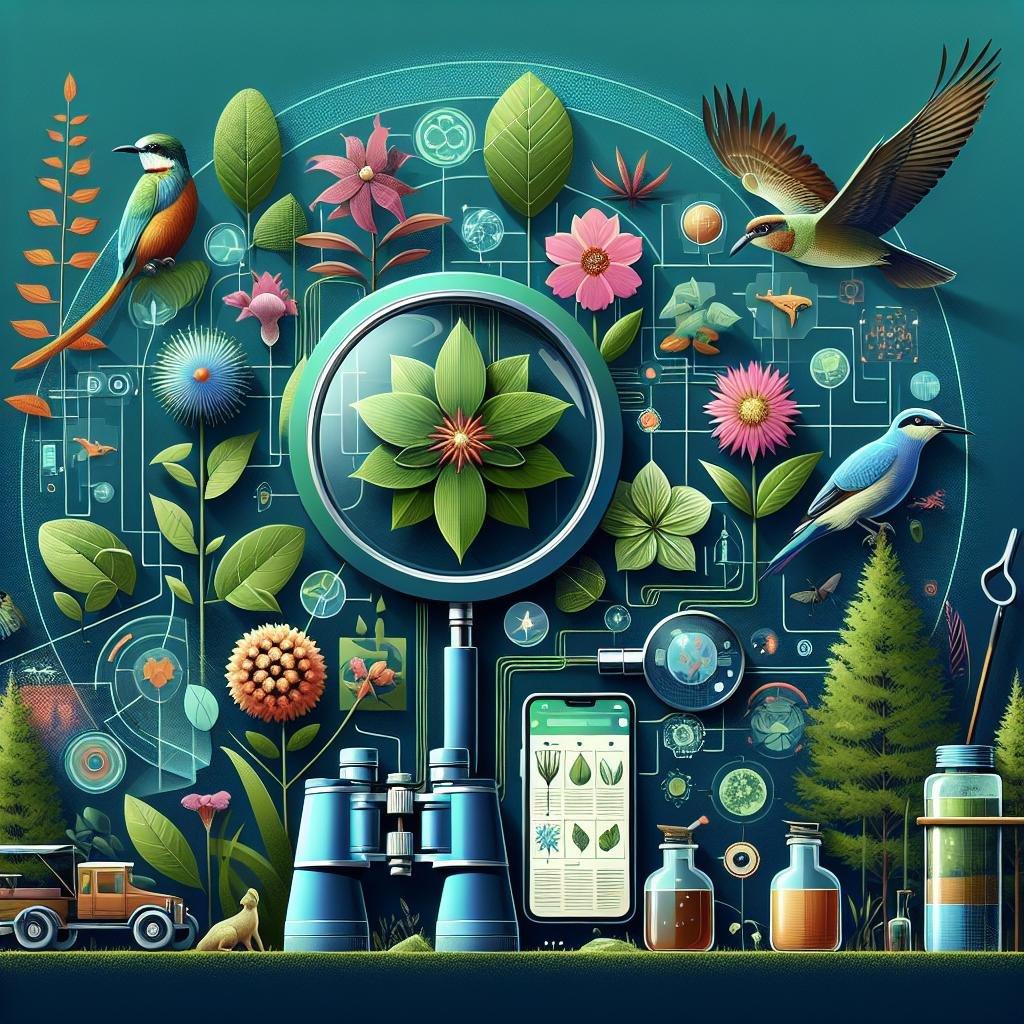As the sun spills its golden hues across the rugged trails winding through nature’s verdant tapestry, a world of discovery unfolds at every step. The footsteps of wanderers and adventurers often echo through these paths, yet many overlook the vibrant symphony of life that thrives beside them. From the delicate rustling of leaves whispering secrets of the forest to the vivid bursts of color that paint both ground and sky, the flora and fauna of hiking trails hold stories waiting to be told. This guide embarks on a journey to illuminate the hidden wonders that breathe life into the wilderness, offering tips and insights on how to spot and identify the local inhabitants of these natural sanctuaries. Whether you’re a seasoned explorer or a curious novice, learning to recognize the subtle signs of life along the trail can transform an ordinary hike into an extraordinary exploration. Join us as we delve into the art of observing nature, embracing the intricate dance of flora and fauna that not only enrich our hikes but also foster a deeper connection to the world around us.
Understanding the Ecosystem: A Closer Look at Trail Habitats
Embarking on a hiking adventure offers a splendid opportunity to delve into the intricate world of trail ecosystems. These environments harbor a diverse array of flora and fauna, each uniquely adapted to the habitat’s specific conditions. While traversing through these natural corridors, one can expect to encounter towering trees providing shade, lush understories, and vibrant wildflowers painting the landscape with myriad colors. Common trees you might spot include oak, pine, or maple, their leaves rustling softly in the breeze. Look closely at the ground, and you’ll catch sight of delicate mosses and ferns, providing shelter for small creatures. The trick is to move slowly and attentively, allowing the environment to reveal its hidden wonders. Keep an ear out for nature’s symphony—the rustle of leaves, chirping birds, and the distant call of a hawk.
Beneath the canopy, wildlife is abound with various critters making their home in these lush environments. Hikers may spot small mammals such as squirrels, chipmunks, or rabbits darting across the path. Birdwatchers might catch glimpses of local avian species like robins, woodpeckers, or warblers resting on branches or soaring above. Amphibians and reptiles are also part of this ecosystem’s tapestry, with frogs croaking near ponds and lizards basking on sunlit rocks. The key to successful identification is knowing where to look and being patient. Use the following tips to enhance your observation skills:
- Carry a modest field guide or use a smartphone app to help identify species on the go.
- Pay attention to distinctive features: leaf patterns, bark texture, and animal markings.
- Observe animal behavior—the way they move and interact can be a clue to their identity.
| Common Flora | Common Fauna |
|---|---|
| Ferns | Squirrels |
| Wildflowers | Robins |
| Mosses | Frogs |


Key Features to Identify Common Plants and Wildlife
Embarking on a hiking adventure offers a brilliant opportunity to connect with nature, and being able to identify local plants and wildlife along the way only deepens that connection. To distinguish between various species, pay close attention to the leaf shapes, bark textures, and flower colors of the flora around you. Leaves can be lobed, serrated, or smooth, each providing a clue to their species. For trees, the bark can be spongy, smooth, or scaly. Identifying flowers by their color and petal arrangement gives insight into the plant’s family. Don’t forget the non-verbal communication nature often uses; the scents and sounds in the environment are also key indicators.
For wildlife observation, being attuned to animal tracks and sounds can be incredibly rewarding. Look for footprints in the soil—deer tracks often appear as heart-shaped marks, while rabbits leave behind oval-shaped impressions. Listening is equally important, as specific birds have unique calls that can guide identification efforts. In your exploration, consider creating an observation table to help differentiate between species:
| Features | Clues |
|---|---|
| Leaves | Lobed, Smooth, Serrated |
| Animal Tracks | Heart-Shaped, Oval Impressions |
| Bird Calls | Unique to Species |
By actively engaging your senses, every hike can transform into a delightful exploration of the natural world.


The Role of Technology in Enhancing Your Nature Exploration
In today’s digital age, embarking on a nature exploration doesn’t have to mean disconnecting from technology; rather, it can be a chance to enhance your outdoor adventures. Smartphones and other gadgets have evolved into powerful companions, aiding us in spotting and identifying local flora and fauna. Apps like Seek by iNaturalist, LeafSnap, and PictureThis are designed to make plant identification a breeze. Simply take a photo of the plant, flower, or tree you come across, and these apps will provide you with immediate information on species, habitat, and even care tips. For bird watchers, apps like Merlin Bird ID and Audubon Bird Guide offer sound recognition technology, confirming bird species from their songs and calls, hence enriching your hiking trails with immediate biodiversity insights.
Gadgets like drones equipped with high-resolution cameras can also be a boon for nature enthusiasts wishing to capture breathtaking views from vantage points that would otherwise be inaccessible. Binoculars with digital capabilities and augmented reality glasses offer new perspectives and enhance wildlife observation without intrusion. Here’s a quick comparison highlighting some of these tech tools:
| Gadget/App | Feature | Use Case |
|---|---|---|
| Seek by iNaturalist | Camera-based identification | Identifies plants and animals |
| Merlin Bird ID | Sound recognition | Identifies bird species by song |
| Drone with Camera | Aerial photography | Capture landscapes and wildlife |
| Digital Binoculars | Magnification with digital overlay | Enhanced wildlife viewing |
While technology can significantly augment your nature exploration, it’s also crucial to be mindful of responsible usage. Always ensure that respect for the natural habitat is maintained by following local guidelines, and remember that technology is a tool to enhance, not disrupt, the sanctity of nature.


Best Practices for Observing and Respecting Native Species
When journeying through nature, it’s crucial to prioritize the protection and respect of the ecosystems you encounter. Start by sticking to designated trails to minimize habitat disturbance. Always observe from a distance, ensuring you don’t interrupt the natural behavior of wildlife. Respect the balance of these ecosystems by keeping sound levels to a minimum, as loud noises can cause unnecessary stress to animals. Avoid handling flora unless necessary and resist the temptation to take souvenirs, as even something as small as a pinecone can play an essential role in the ecosystem.
To further practice respect, it’s helpful to be informed about the local species you might encounter. Equip yourself with a regional field guide or a plant identification app and take time to educate yourself before you set out. Knowing what to look for can enhance your experience and increase appreciation for the diversity of local wildlife. Below are some categories of species you might observe:
- Mammals: squirrels, deer, rabbits
- Birds: woodpeckers, owls, songbirds
- Reptiles: lizards, snakes
- Plants: wildflowers, ferns, moss
| Category | Common Species |
|---|---|
| Mammals | Gray Squirrel |
| Birds | Blue Jay |
| Reptiles | Garter Snake |
| Plants | Trillium |
Q&A
Q&A: Exploring Nature’s Wonders on Hiking Trails
Q1: Why is it important to learn how to spot and identify local flora and fauna while hiking?
A1: Understanding and identifying local flora and fauna enriches your hiking experience by connecting you more deeply with the natural environment. It enhances your awareness of biodiversity, helps in conservation efforts, and can ensure safety by identifying poisonous plants or dangerous animals.
Q2: What are some essential tools or guides to bring on a hike for identifying plants and animals?
A2: Consider bringing a field guide specific to the region you’re exploring, which can include detailed information and images of local species. Smartphone apps like iNaturalist or PlantSnap are excellent technological alternatives. A notebook and pencil can be valuable for jotting down observations.
Q3: How can digital apps assist in identifying flora and fauna on the trails?
A3: Digital apps boast features such as image recognition, which allows hikers to snap a photo and receive instant identification and information about plants and animals. Many apps also allow users to record their findings and contribute to citizen science projects, helping track species’ locations and populations.
Q4: What should hikers be mindful of when trying to spot and identify wildlife?
A4: Patience and stealth are key when observing wildlife. Moving quietly and blending in with the environment increases your chances of encountering animals in their natural behavior. Additionally, maintaining a respectful distance ensures safety for both you and the animals.
Q5: Can you recommend any beginner-friendly strategies for learning the basics of plant and animal identification?
A5: Start with observing and identifying common and distinctive species, such as iconic flowers or mammals. Notice unique plant leaf shapes, colors, and patterns. Listening to birdsong or looking for animal tracks and signs can also provide clues. Engage with local nature clubs or online forums to gain insights from more experienced naturalists.
Q6: How can hikers differentiate between similar-looking plant species?
A6: Paying attention to specific characteristics such as leaf arrangement, flower structure, and habitat can help distinguish similar species. Many plants have distinguishing features that become apparent through careful examination, such as the texture of leaves or the scent of flowers.
Q7: What role do local flora and fauna play in the ecosystem that hikers should appreciate?
A7: Local flora and fauna contribute to the ecosystem by maintaining the balance and health of the environment. Plants provide oxygen, food, and shelter for animals, while animals aid in processes like pollination and seed dispersal. Recognizing their roles fosters a greater appreciation and respect for nature.
Q8: Are there any common misconceptions about spotting wildlife during hikes?
A8: A common misconception is that wildlife is hidden or avoiding human contact. In reality, many animals are active in plain sight but require keen observation to notice. Additionally, some believe only remote areas offer wildlife encounters when, in actuality, even urban trails can be rich in biodiversity.
By enhancing your skills in spotting and identifying local flora and fauna, you’ll not only gain a deeper understanding of your surroundings but also become a more responsible and informed explorer of the natural world. Happy hiking!
Insights and Conclusions
As you lace up your boots and venture out onto the winding paths, may this guide serve as your compass for discovery, illuminating the wilderness around you with every step. With your newfound ability to recognize the verdant flora as it sways gently in the breeze and to identify the elusive fauna that scurries through the underbrush, the trail transforms from a mere sequence of footsteps to a tapestry of life waiting to be explored. Remember that each hike is not just a journey through nature, but a dialogue with the land itself—a story unfolding in petals and pawprints, waiting for the keen observer to read. Whether you find solace in the rustling leaves or excitement in a sudden flutter of wings, your walks in the wild have grown richer, promising countless new adventures. So, step lightly, observe keenly, and let the trail guide you into its gallery of natural wonders.

